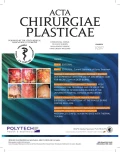MIKROMYCETÁRNÍ INFEKCE U PACIENTŮ S TERMICKÝM TRAUMATEM
Autoři:
B. Lipový 1,2; J. Holoubek 1; H. Řihová 1; Y. Kaloudová 1; M. Hanslianová 3; M. Cvanová 4; J. Jarkovský 4
; I. Suchánek 1; P. Brychta 1,2
Působiště autorů:
Department of Burns and Reconstructive Surgery, University Hospital Brno, Czech Republic
1; Medical Faculty, Masaryk University, Czech Republic
2; Department of Clinical Microbiology, University Hospital Brno, Czech Republic
3; Institute of Biostatistics and Analyses, Medical Faculty, Masaryk Universit, Czech Republic
4
Vyšlo v časopise:
ACTA CHIRURGIAE PLASTICAE, 59, 1, 2017, pp. 27-32
Zdroje
1. Glik J, Kawecki M, Gaździk T, Nowak M. The impact of the types of microorganisms isolated from blood and wounds on the results of treatment in burn patients with sepsis. Pol Przegl Chir. 2012 Jan;84(1):6–16.
2. Lipový B et al. Prevalence of infectious complications in burn patients requiring intensive care: data from a pan-European study. Epidemiol Mikrobiol Imunol. 2016 Mar;65(1):25–32.
3. Lipový B et al. Unsuccessful therapy of combined mycotic infection in a severely burned patient: a case study. Acta Chir Plast. 2009;51(3–4):83–4.
4. Cochran A, Morris SE, Edelman LS, Saffle JR. Systemic Candida infection in burn patients: a case-control study of management patterns and outcomes. Surg Infect (Larchmt). 2002 Winter;3(4):367–74.
5. Tobiasen J, Hiebert JM, Edlich RF. The abbreviated burn severity index. Ann Emerg Med. 1982 May;11(5):260–2.
6. Nash G, Foley FD, Goodwin MN Jr, Bruck HM, Greenwald KA, Pruitt BA Jr. Fungal burn wound infection. JAMA. 1971 Mar 8;215(10):1664–6.
7. Santucci SG, Gobara S, Santos CR, Fontana C, Levin AS. Infections in a burn intensive care unit: experience of seven years. J Hosp Infect. 2003 Jan;53(1):6–13.
8. Nasser S, Mabrouk A, Maher A. Colonization of burn wounds in Ain Shams University Burn Unit. Burns. 2003 May;29(3):229–33.
9. Ballard J et al.; Multicenter Trials Group, American Burn Association. Positive fungal cultures in burn patients: a multicenter review. J Burn Care Res. 2008 Jan-Feb;29(1):213–21.
10. Becker WK et al. Fungal burn wound infection. A 10-year experience. Arch Surg. 1991 Jan;126(1):44–8.
11. Mousa HA. Fungal infection of burn wounds in patients with open and occlusive treatment methods. East Mediterr Health J. 1999 Mar;5(2):333–6.
12. apoor MR, Sarabahi S, Tiwari VK, Narayanan RP. Fungal infections in burns: Diagnosis and management. Indian J Plast Surg. 2010 Sep;43(Suppl):S37–42.
13. Ráčil Z et al. Detection of 1,3-beta-D glucan for diagnosis of invasive fungal infections in hematooncological patients: usefulness for screening of invasive mycosis and for confirmation of galactomannan positive results. Klin Mikrobiol Infekc Lek. 2009 Apr;15(2):48–57.
14. Piazza RC, Thomas WL, Stawski WS, Ford RD. Mucormycosis of the face. J Burn Care Res. 2009 May–Jun;30(3):520–3.
Štítky
Chirurgie plastická Ortopedie Popáleninová medicína TraumatologieČlánek vyšel v časopise
Acta chirurgiae plasticae

2017 Číslo 1
- Metamizol jako analgetikum první volby: kdy, pro koho, jak a proč?
- MUDr. Lenka Klimešová: Multioborová vizita může být klíčem k efektivnější perioperační léčbě chronické bolesti
- Neodolpasse je bezpečný přípravek v krátkodobé léčbě bolesti
- Léčba akutní pooperační bolesti z pohledu ortopeda
Nejčtenější v tomto čísle
- OPERAČNÍ LÉČBA HLUBOKÝCH POPÁLENIN METODOU MEEK MIKROGRAFTINGU V POPÁLENINOVÉM CENTRU FN OSTRAVA
- HISTORIE, SOUČASNOST A PERSPEKTIVY ČESKÉ POPÁLENINOVÉ MEDICÍNY
- NAŠE ZKUŠENOSTI S VYUŽITÍM 40% KYSELINY BENZOOVÉ PŘI NEKREKTOMII U HLUBOKÝCH POPÁLENIN
- MIKRONEEDLING – FORMA KOLAGEN INDUKČNÍ TERAPIE JIZEV – NAŠE PRVNÍ ZKUŠENOSTI
